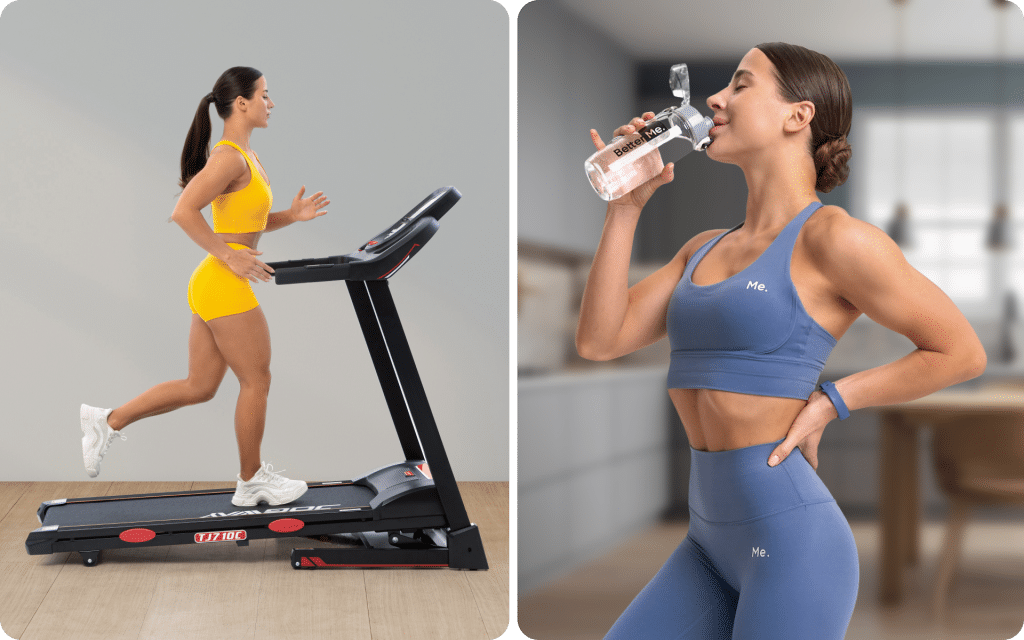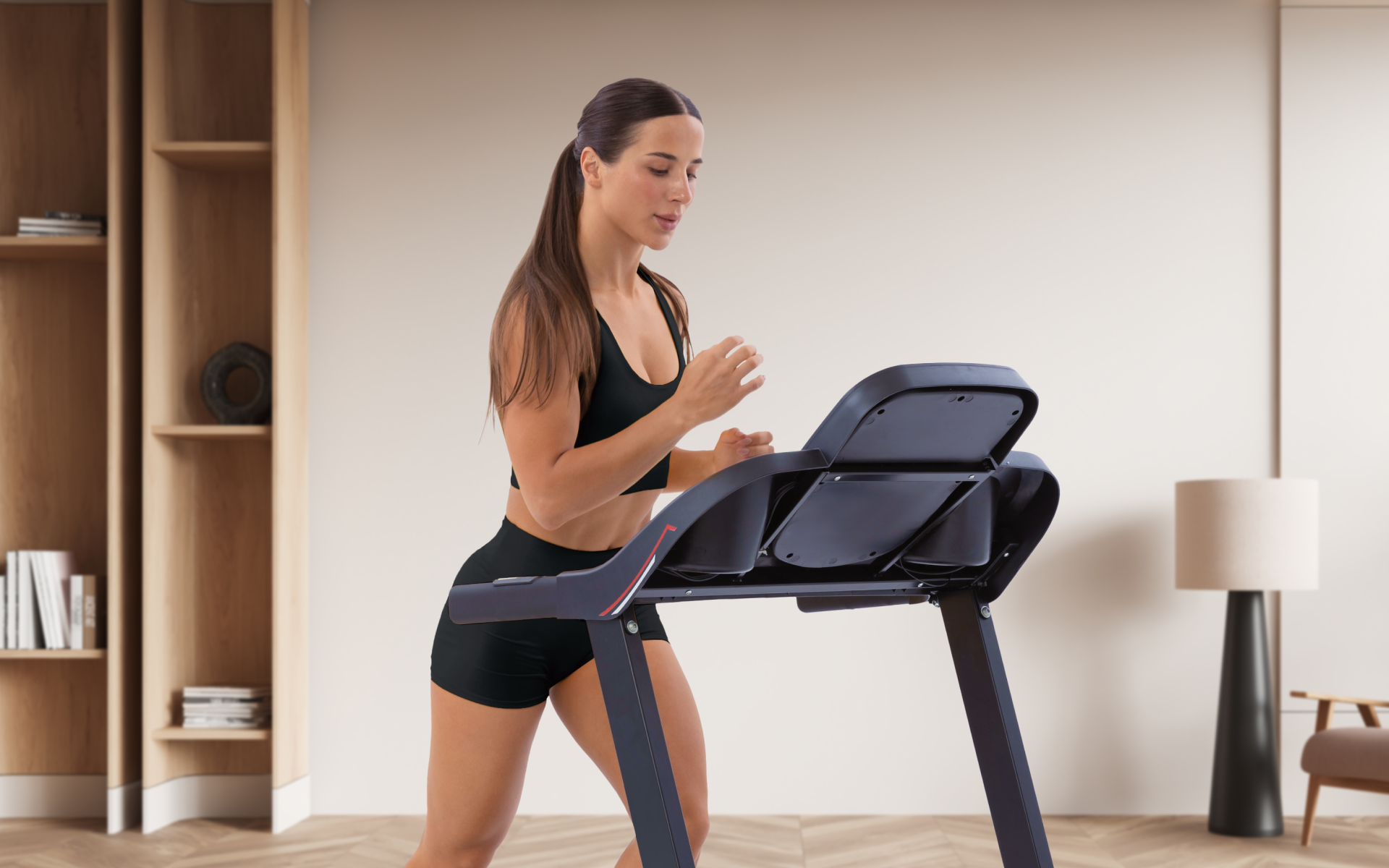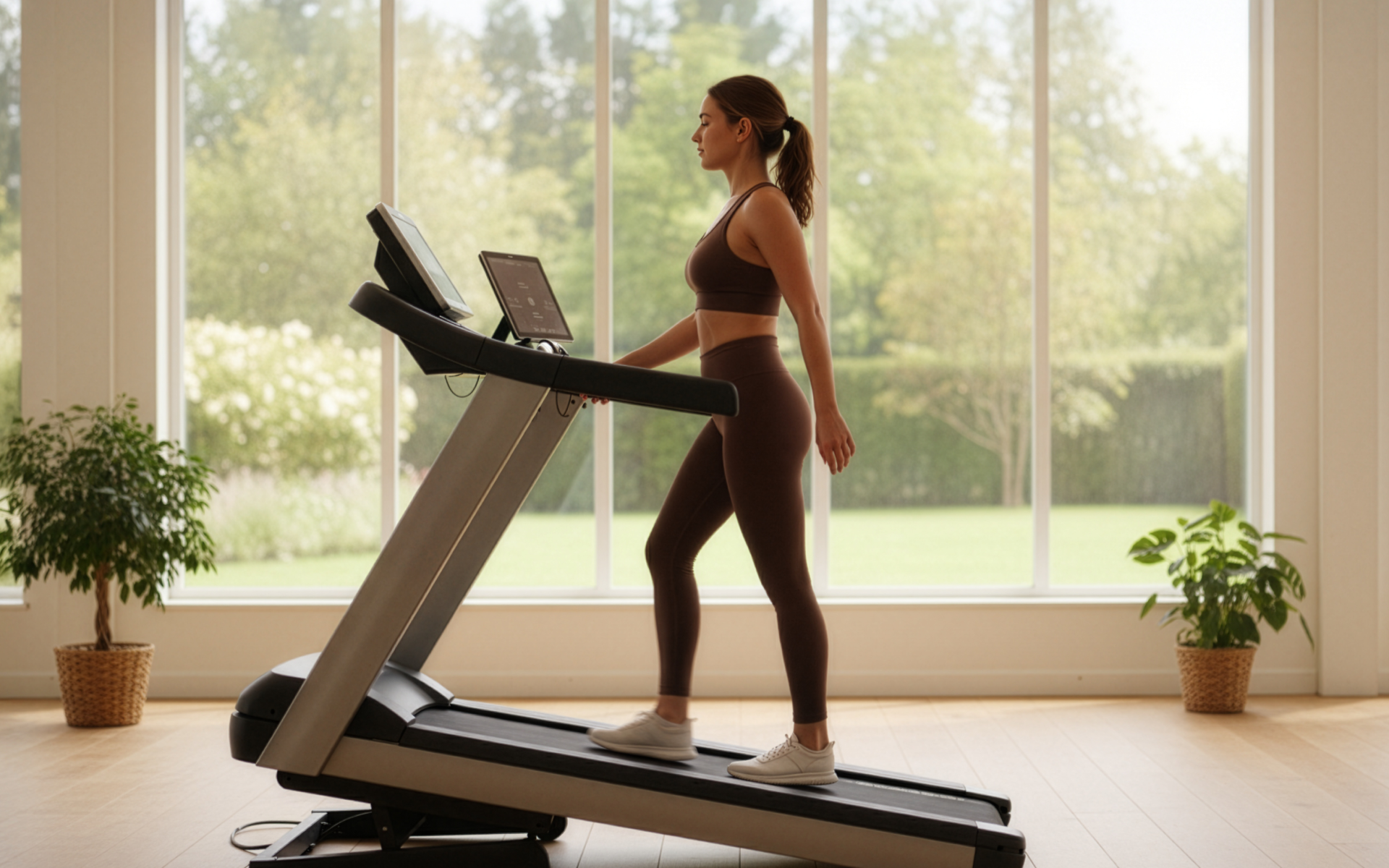Sprinting is one of the most efficient ways to improve cardiovascular health, torch calories, and build lean muscle. It’s explosive, challenging, and when done right, it can deliver serious results in a short amount of time.
But sprinting isn’t just about running as fast as you can; it’s a skill that demands proper technique, gradual progression, and respect for your body’s limits. This is particularly true for beginners, as sprinting places unique demands on your muscles, joints, and energy systems.
If you’re ready to incorporate sprints into your treadmill workouts but don’t know where to start, you’ve come to the right place. This guide will walk you step-by-step through a beginner-friendly approach to treadmill sprinting so you can train safely.
Is Sprinting on a Treadmill Effective?
Treadmill sprinting is undeniably effective. From building cardiovascular strength to refining sprint mechanics, it serves as a valuable tool in any fitness program. While it may not replicate the complexity of outdoor running, it offers versatility, safety, and precision, particularly for beginners or anyone who is looking to fine-tune their explosive power.
Here’s why sprinting on a treadmill works:
- Controlled Environment: The treadmill allows you to focus on explosive efforts without unpredictable elements such as uneven terrain or weather.
- Controlled Speeds for Gradual Progression: Unlike outdoor sprints, where you may guess your effort level, treadmills allow you to set precise speeds. Beginners can start slow and progressively increase intensity as their confidence and strength increase.
- Incline Settings for an Extra Challenge: The treadmill’s incline feature is a game-changer. Running uphill increases the load on your glutes, hamstrings, and calves, building explosive power without the need for high speeds.
- Reinforces Consistent Mechanics: The steady pace of the belt encourages proper stride cadence and rhythm. Over time, this can translate into smoother, more efficient mechanics outdoors.
- Tracks Progress in Real Time: Metrics such as speed, time, distance, and calories burned make it easy to measure your performance. Tracking encourages consistency and provides tangible milestones.
- Customizable Work-to-Rest Ratios: Whether you’re doing 20-second sprints with a minute of rest or experimenting with Tabata-style intervals, the treadmill timer ensures you hit precise work-recovery ratios.
BetterMe: Health Coaching app helps you achieve your body goals with ease and efficiency by helping to choose proper meal plans and effective workouts. Start using our app and you will see good results in a short time.
Skill-Specific Benefits of Treadmill Sprinting
While treadmill sprinting isn’t an exact replica of outdoor sprints, it trains several sprint-related skills that improve performance over time:
- Stride Cadence and Length: The belt’s motion helps you understand pacing and rhythm. Running at a steady set speed can train your legs to stick to a consistent stride pattern (1).
- Hamstring and Glute Engagement: By working against the moving belt, you naturally activate the posterior chain muscles, which are critical for sprinting power (2).
- Neuromuscular Coordination: Consistent sprint practice on a treadmill sharpens the connection between your brain and muscles, enhancing movement efficiency (3).
Limitations Compared to Outdoor Sprinting
Of course, treadmill sprinting isn’t without its caveats:
- Lack of Variability: Outdoor sprints naturally simulate real-life challenges such as turns, uneven terrain, wind resistance, and energy shifts. Treadmill running, on the other hand, can feel overly static.
- Movement Pattern Difference: With a treadmill, the belt moves beneath you, slightly altering the mechanics of your stride. Some argue that this reduces the workload that is needed to propel yourself forward.
- Mental Engagement: Indoor training can feel monotonous for some people, while outdoor sprints offer variety and mental stimulation.
Read more: Treadmill Weight Loss: Effective Strategies and Workouts
How to Train Sprints on a Treadmill
Effective sprint training is more than just running fast, it’s a strategic combination of preparation, execution, and recovery. To get the most out of sprints, especially as a beginner, you must pay attention to several key aspects.
- Proper Warm-Up
A thorough warm-up is essential for peak performance and injury prevention. Sprinting places immense stress on your muscles, tendons, and cardiovascular system, so jumping into high-intensity effort without preparation is risky (4).
Start with 5-10 minutes of light cardio, such as walking or jogging, to increase your heart rate and blood flow. Follow this with dynamic stretches that target key sprinting muscles, such as hip flexors, glutes, hamstrings, and calves.
Examples include leg swings, high knees, and walking lunges.
Studies have shown that dynamic warm-ups improve muscle elasticity and mobility, priming your body for explosive movements while minimizing injury risks (5).
- Mastering Technique
Efficient sprinting mechanics not only improve performance but also reduce unnecessary strain on your body. To maximize power, focus on these tips:
- Knee Drive: Actively drive your knees upward, aiming for a 90-degree angle at the hip. This engages your hip flexors and elongates your stride for more ground coverage.
- Arm Action: Pump your arms back and forth at a 90-degree angle, keeping your hands relaxed. Your arms dictate rhythm, and strong arm action counterbalances leg movement.
- Pelvic Position: Maintain a slight forward lean, keeping your core engaged. Avoid an exaggerated tilt, which can destabilize your entire stride.
- Foot Strike: Land on the balls of your feet instead of your heels. This improves shock absorption and utilizes the springy energy in your Achilles tendon for faster propulsion.
- Intensity and Duration
Elite sprinters may hit top speeds for seconds at a time, but beginners must build intensity carefully. Sprinting is a form of anaerobic exercise that heavily taxes your energy systems, so start slow (6).
Research has suggested that performing sprints at 80–90% of your max effort is sufficient for significant training adaptations without overexertion (7).
Limit sprint durations to 20–30 seconds early on – this aligns with your anaerobic capacity and allows you to maintain proper form.
Gradual progression in both speed and duration over time will ensure consistent gains in strength and cardiovascular endurance.
- Recovery Intervals
Rest intervals are just as important as the sprints themselves. During recovery, your body replenishes adenosine triphosphate (ATP), the key energy molecule for short bursts of activity. It also clears out lactic acid, which accumulates during high-intensity efforts (8).
Aim for a work-to-rest ratio of 1:3 or 1:2, depending on the intensity. For example, sprint for 20 seconds and walk for 60–90 seconds.
Active recovery, such as walking or light jogging, keeps your blood circulating and helps with faster recovery. Neglecting recovery reduces performance and also risks overtraining and burnout (9).
Reasons why BetterMe is a safe bet: a wide range of calorie-blasting workouts, finger-licking recipes, 24/7 support, challenges that’ll keep you on your best game, and that just scratches the surface! Start using our app and watch the magic happen.
- Building Gradual Progression
Consistency is the foundation of sprint training success. Rushing into high speeds or excessive repetitions often leads to fatigue or injuries, such as hamstring strains.
Begin with 4-6 sprint intervals per workout, and prioritize quality over quantity. Over a few weeks, gradually increase intensity, incline, or the number of intervals, but only one factor at a time.
Remember, progress stems from pushing your limits in a controlled manner, not from doing too much, too soon.
What Is a Good Treadmill Sprint Workout?
A good treadmill sprint workout for beginners focuses on building speed, strength, and endurance safely. The following schedule is tailored to ease you into high-intensity training while prioritizing proper form and adequate recovery. Each phase serves a specific purpose, so let’s break it down.
Warm-Up (5–10 minutes)
Start with 5 minutes of brisk walking or light jogging at 3-4 mph. Add dynamic stretches such as leg swings, lunges, and high knees.
Sprint Intervals (20–30 minutes total)
This phase alternates between high-intensity sprints and active recovery. Follow these steps:
- Sprint: 20 seconds at 70-80% of your maximum effort. For beginners, this means a speed of 6-8 mph. Gradually work up to 80-90% effort (8-10 mph) as your confidence increases.
- Recovery: Slow down to a walk or very light jog at 3-5 mph for 90 seconds.
- Rounds: Perform 6 rounds of sprints and recovery intervals. Beginners should start with fewer rounds (3-4) if needed and build up over several weeks.
Cool-Down (5–10 minutes)
Gradually lower your intensity with 5 minutes of light walking at 2-3 mph. Finish with static stretches that target the hamstrings, quads, hip flexors, and calves.
Schedule Overview
| Phase | Duration | Intensity/Speed | Purpose |
|---|---|---|---|
| Warm-Up | 5–10 minutes | 3–4 mph (walking/jogging) | Warm muscles, prevent injury |
| Sprint | 20 seconds | 6–8 mph (70–80% effort) | Build power, challenge the anaerobic system |
| Recovery | 90 seconds | 3–5 mph (walking/jogging) | Replenish energy, maintain form |
| Sprint Rounds | 6 rounds | Alternate sprint/recovery | Progressive improvement in fitness |
| Cool-Down | 5–10 minutes | 2–3 mph (walking/stretching) | Lower heart rate, help with recovery |
Progression Plan
- Weeks 1–2: Start with 4 intervals. Sprint at a moderate pace (6-7 mph).
- Week 3–4: Increase to 5-6 intervals. Push closer to 8 mph for sprints.
- Week 5+: Add an additional round or raise your sprint speed slightly. Experiment with incline (1–2%) for a greater challenge as you adapt.
How Many Treadmill Sprints Should I Do?
The answer is dependent on your fitness level, goals, and how well your body handles recovery. Sprinting is intense, so the number of intervals you perform needs to match your experience and capacity. Doing too much too soon can lead to fatigue, poor performance, and even injuries. Here’s how to figure out what’s right for you.
For Beginners
If you’re new to sprinting, start small. Aim for 3-4 sprint intervals per session, gradually increasing to 5-6 over the course of a few weeks. Each sprint should last around 20—0 seconds, followed by 60 seconds of recovery (10). This lets you tap into high-intensity training without overtaxing your muscles and energy systems. Consistency is far more important than volume at first.
Progression Over Time
Your body will adapt to sprint training through repeated exposure (11). After 2-4 weeks, you can add an extra sprint interval or slightly increase your sprint duration. For example:
- Weeks 1–2: 4 intervals, 20 seconds sprinting, 90 seconds recovery.
- Weeks 3–4: 5 intervals, 25 seconds sprinting.
- Week 5+: 6 intervals, 30 seconds sprinting, or add a 1% incline for more challenge.
Progress at your own pace – there’s no rush. Quality sprints with proper form outweigh the benefits of simply adding more rounds.
Listen to Your Body
Everyone’s recovery capacity is different, so paying attention to how you feel is essential. Signs you may be doing too many sprints include:
- Struggling to maintain your speed by the last interval.
- Form breaking down (e.g.,= dragging your feet or losing arm coordination).
- Prolonged fatigue or muscle soreness that lingers for days.
If you notice any of these, dial it back. Reduce the number of sprints or take longer recovery periods. Remember, your body grows stronger during rest, not during the workout itself.
Avoiding Overtraining
Sprinting stresses your nervous system, muscles, and cardiovascular system (6), so it’s best to limit sprint sessions to 2-3 times per week. Giving yourself at least 24-48 hours of recovery between sessions helps prevent overtraining and ensures top performance in each workout.
Tailoring to Your Goals
- For Fat Loss: Go for 5-8 sprints per session as your endurance improves. Sprint intensity burns calories, but it’s consistency and gradual progression that drive long-term results.
- For Speed and Power: Perform 4-6 sprints with greater focus on form and explosive effort. Shorter sprints (15-20 seconds) at near-max intensity are ideal for targeting fast-twitch muscle fibers.
- For General Fitness: Stick with 4-6 intervals, aiming for sustainable effort and recovery. You don’t need to go all-out every session – maintaining consistency and proper technique is key.
Is It OK to Do Treadmill Sprint Workouts Every Day?
The short answer? Not really. While sprinting is a powerful tool for building fitness and burning calories, doing it every single day can do more harm than good. Sprinting taxes your body intensely, stressing your muscles, joints, nervous system, and cardiovascular system (6). Without proper recovery, you risk fatigue, reduced performance, and even injury.
Your body doesn’t actually get stronger during a workout – it improves during recovery. When you sprint, you create tiny tears in your muscle fibers and deplete your energy stores.
Rest days allow your body to repair this damage, replenish energy, and adapt to become stronger (12). Skipping these crucial rest periods interrupts this cycle, leading to overtraining, which can stall progress or, worse, lead to burnout or injury.
Read more: 28-Day Treadmill Weight Loss Challenge for Beginners
What Is the Best Treadmill Sprint Time to Lose Weight?
When it comes to losing weight, treadmill sprinting can be an incredibly effective tool. Not only does it torch calories during the workout, it also boosts your metabolism long after you’ve finished thanks to the afterburn effect (also known as excess post-exercise oxygen consumption or EPOC) (13).
But is there a “best sprint time” to shed pounds? The truth is, weight loss is less about a specific sprint duration and more about consistent effort, a sustainable routine, and pairing it with the right nutrition.
The best treadmill sprint session is one you can stick with, and progress gradually over time. A short, moderate session done consistently will yield better results than “perfect” but sporadic workouts.
Remember, no amount of sprinting can outwork a consistently excessive calorie intake. The combination of a clean diet and high-intensity training creates the perfect environment for fat loss.
Yes, 20 minutes on a treadmill can be highly effective, particularly for beginners or those with time constraints. A high-intensity sprint workout within this timeframe can boost calorie burn, improve cardiovascular fitness (14), and elevate metabolism due to the afterburn effect (13). It’s a manageable duration for consistent effort without overtaxing your body. Sprints can help reduce belly fat as they are a form of high-intensity interval training (HIIT), which has been shown to burn calories and target fat stores (14), including visceral fat around the abdomen. However, spot-reduction isn’t possible – overall fat loss is achieved through a calorie deficit and regular exercise, which includes sprinting. The 3-2-1 treadmill workout alternates between high, moderate, and low intensities. You sprint for 3 minutes, jog for 2 minutes, and walk for 1 minute, repeating the pattern multiple times. It’s a flexible and challenging routine designed to improve endurance and burn calories efficiently. You can also discover how to adapt the popular 12-3-30 workout for effective results without needing a treadmill. The 12/3/30 treadmill workout, which involves walking at a 12% incline at 3 mph for 30 minutes, is effective for improving cardiovascular health and burning calories. While it’s less intense than sprinting, the incline increases muscle activation and calorie burn, which makes it a good option for steady-state cardio or recovery days.Frequently Asked Questions
Is 20 minutes on the treadmill okay?
Do sprints burn belly fat?
What is the 3-2-1 treadmill workout?
Does 12/3/30 actually work?
The Bottom Line
Treadmill sprint workouts are an effective way to boost fitness, burn fat, and improve cardiovascular health. For the best results, focus on proper form, adequate recovery, and staying consistent. Pair sprints with a healthy diet for sustainable weight loss and long-term benefits.
DISCLAIMER:
This article is intended for general informational purposes only and does not serve to address individual circumstances. It is not a substitute for professional advice or help and should not be relied on for making any kind of decision-making. Any action taken as a direct or indirect result of the information in this article is entirely at your own risk and is your sole responsibility.
BetterMe, its content staff, and its medical advisors accept no responsibility for inaccuracies, errors, misstatements, inconsistencies, or omissions and specifically disclaim any liability, loss or risk, personal, professional or otherwise, which may be incurred as a consequence, directly or indirectly, of the use and/or application of any content.
You should always seek the advice of your physician or other qualified health provider with any questions you may have regarding a medical condition or your specific situation. Never disregard professional medical advice or delay seeking it because of BetterMe content. If you suspect or think you may have a medical emergency, call your doctor.
SOURCES:
- Influence of Stride Frequency and Length on Running Mechanics: A Systematic Review (2013, journals.sagepub.com)
- Sprint Acceleration Mechanics: The Major Role of Hamstrings in Horizontal Force Production (2015, frontiersin.org)
- Neuromuscular Control in Incline and Decline Treadmill Running: Insights into Movement Synergies for Training and Rehabilitation (2024, mdpi.com)
- Impact of warm-up methods on strength-speed for sprinters in athletics: a mini review (2024, frontiersin.org)
- Effects of Warm-Up, Post-Warm-Up, and Re-Warm-Up Strategies on Explosive Efforts in Team Sports: A Systematic Review (2018, researchgate.net)
- Anaerobic Exercise (n.d., physio-pedia.com)
- Muscle Energetics During Explosive Activities and Potential Effects of Nutrition and Training (2014, springer.com)
- Physiological Adaptations to Sprint Interval Training with Matched Exercise Volume (2016, paulogentil.com)
- A Systematic Review on the Effectiveness of Active Recovery Interventions on Athletic Performance of Professional-, Collegiate-, and Competitive-Level Adult Athletes (2019, journals.lww.com)
- Repeated-Sprint Ability — Part II (2012, springer.com)
- The Effects of Repeated-Sprint Training on Physical Fitness and Physiological Adaptation in Athletes: A Systematic Review and Meta-Analysis (2023, springer.com)
- The importance of rest and recovery for athletes (2013, msu.edu)
- Excess Postexercise Oxygen Consumption After High-Intensity and Sprint Interval Exercise, and Continuous Steady-State Exercise (2016, journals.lww.com)
- Evidence-Based Effects of High-Intensity Interval Training on Exercise Capacity and Health: A Review with Historical Perspective (2021, mdpi.com)










